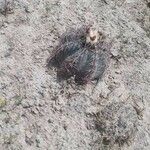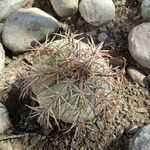Plants normally unbranched. Stems pale gray-green to bright gray-blue, flat-topped or hemi-spheric and deep-seated in sub-strate, spheric with age or stoutly short cylindric (remaining hemi-spheric at high elevations), 4-25(-45) × 8-15(-20) cm; ribs (7-)8(-9), vertical to helically curving around stem, rib crests broadly rounded, uninterrupted or slightly constricted between areoles. Spines (5-)8(-10) per areole, loosely projecting or strongly decurved, pink, gray, tan, or brown, strongly annulate-ridged, subulate, ± flattened, glabrous, generally not hiding stem surface; radial spines 5(-8) per areole, similar to central spines; central spines 1(-3) per areole, 18-43 × 1-2.5(-3) mm, longest spine usually descending, straight or decurved throughout its length. Flowers 5-7 × 5-6.5(-9.5) cm; inner tepals bright rose-pink or magenta, color ± uniform from base to apex, 3 × 1.5 cm, margins entire to serrate; stigma lobes pinkish to olive. Fruits indehiscent or weakly dehiscent through basal abscission pore, pink or red, spheric to ovoid-cylindric, surfaces partly or entirely hidden by hairs from axils of scales and long areolar hairs of stem apex, usually quickly drying to tan shell before seed dispersal, 10-30 mm; scales several, tips dark, spinelike, glabrous. Seeds black or gray, angular or slightly wrinkled, spheric to obovoid, 2-3 mm; testa cell surfaces slightly convex, with weak network pattern of slightly protruding anticlinal cell walls. 2n = 22.
More
A small cactus. It is usually single but can form small clumps. The stem can be 20 cm across. Some kinds can be 40 cm high. The cactus is round. The spines vary a lot. The flowers are purple-red. They are 5 cm across. The fruit is juicy at first but then becomes dry.
Semidesert areas, growing in xerophyllous scrub, on several types of substrates, including the limestone soils of rocky hills; at elevations from 600-1,700 metres, occasionally to 2,500 metres.
More
It is a subtropical plant. It is best in light sandy, well-drained soils. It needs an open, sunny position. It is resistant to frost and drought.



